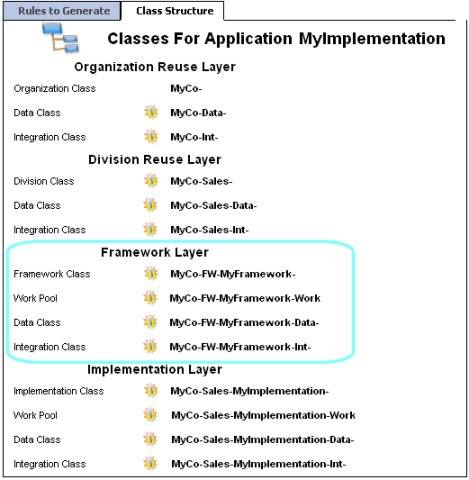
 Framework class
Framework class
A framework class is a class that belongs to a RuleSet that is not one of your application RuleSets — those RuleSets that appear in the Application RuleSets area of the General tab of your application rule (plus the RuleSets that appear in the Application RuleSets area of other application rules, in certain cases).
![]() Don't confuse framework classes — an important part of any application built using Direct Capture of Objectives tools — with Pegasystems' solution frameworks — which are starter applications for specific industries or lines of business.
Don't confuse framework classes — an important part of any application built using Direct Capture of Objectives tools — with Pegasystems' solution frameworks — which are starter applications for specific industries or lines of business.
When you create an application with the Application Accelerator, you can choose to create both framework and implementation classes, as in this example. For framework classes, the second segment of the class name is FW.
Classes for the implementation are sometimes called the implementation layer. Classes associated with the framework are sometimes called the framework layer.

Use the Class Inheritance display tool to identify these classes and their relationships.
When you create a new rule, you can restrict the Applies to SmartPrompt list to show only framework classes or show only implementation classes. For an example, see![]() PDN article 25648 Filtering New and Save As Applies To Classes.
PDN article 25648 Filtering New and Save As Applies To Classes.
Typically, work items belong only to implementation classes (work types). To simplify development of list view and summary view reports, you can define reports in framework classes that, at runtime, execute with the corresponding implementation classes.
The Application Accelerator produces multiple classes and RuleSets. For a description of each, see the ![]() PDN article 27472 Understanding class structure and RuleSets generated by the Application Accelerator.
PDN article 27472 Understanding class structure and RuleSets generated by the Application Accelerator.
See also 26421 Adding a work type to a framework and to its implementation layer.

|
application RuleSet, Application Accelerator, implementation class, solution framework |

|
Designer Studio basics — Completing the new rule dialog box
About the Class Inheritance display |
 Definitions — F
Definitions — F